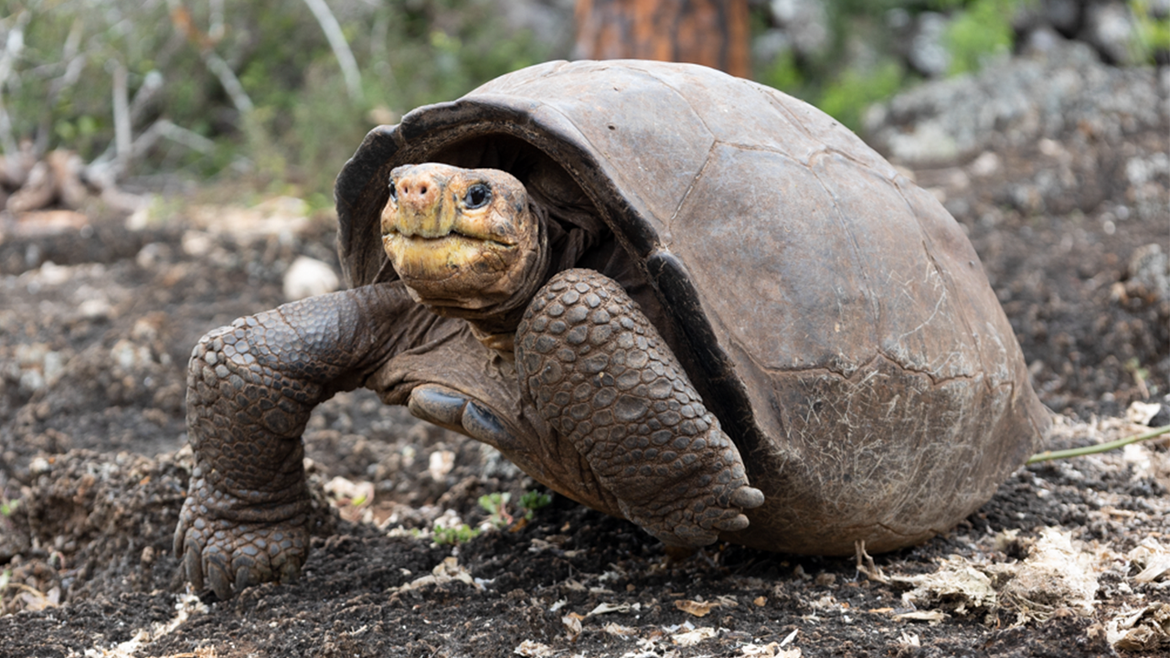Fernanda the giant tortoise is currently the last and only known tortoise in her species.
Researchers confirmed on June 9 that the Galápagos giant tortoise, thought to be extinct for more than a century, is in fact, not.
A team of conservationists and explorers sent out to Fernandina Island, the youngest and most volcanically active island in the Galápagos, in 2019 and came across a wild discovery researchers told The Washington Post: one female giant tortoise, who the researchers named Fernanda.
The spotting of the giant tortoise came after years of hints that the species may still exist after its last spotting in 1906.
In the 1960s, there were reports of tortoise scat on Fernandina Island, though those alleged sightings were “tenuous at best,” researchers told The Washington Post.
Despite the fact that Fernanda was the first tortoise discovered on the island in over a century, experts were unsure if she belonged to the same species as the long-thought-to-be-extinct Chelonoidis phantasticus, or Fernandina Island tortoise.
According to a Princeton University news release, many ecologists questioned if Fernanda was a native phantasticus turtle when she was discovered. She lacked the male historical specimen's distinctive flared shell. However, experts suggest that her stunted growth may have affected her appearance.
Experts suggested that Fernanda may have floated from one island to another or dragged through the water during a hurricane or storm, maybe even moved by surfers.
“We saw — honestly, to my surprise — that Fernanda was very similar to the one that they found on that island more than 100 years ago, and both of those were very different from all of the other islands’ tortoises,” said Stephen Gaughran, who conducted the analyses in February 2021.
To determine Fernanda’s exact species, Princeton University reported that Gaughran sequenced her entire genome and compared it to the genome of the historical specimen collected in 1906. Researchers were able to confirm that Fernanda is in fact part of the same lineage. This Fernandina giant tortoise was part of “a current known population size of a single individual,” researchers told The Washington Post.
Fernanda is considered an “endling,” according to the report by The Washington Post, otherwise known as the last known individual in a species or subspecies.
Explorers found Fernanda relaxing in a spot between some rocks and plants, and she is now living at the Galápagos National Park Tortoise Center where experts are seeing what they can do to keep her species alive, according to Princeton University.
There are 13 additional species of tortoise on the Galápagos Islands, all derived from the same ancestor, as reported by The Washington Post. There are still 12 species alive, all of which are endangered. Another lineage famously ended in 2012, with the death of endling Lonesome George.
Galápagos tortoises can grow to be over five feet long, weigh over 500 pounds, and live for over a century. Fernanda is small for her species, but she is thought to be over 50 years old, potentially because of restricted development and inadequate vegetation in her habitat, according to the study.
Volcanic activity on the island has caused some to fear the worst for the species. “Those rugged conditions are likely what made it possible for Fernanda to avoid notice for all these years,” Gaughran wrote to The Washington Post. “Expeditions to the island can be difficult, so there are likely many places for tortoises — even giant ones! — to hide.”
“The finding of one alive specimen gives hope and also opens up new questions, as many mysteries still remain,” ecologist Adalgisa Caccone, a senior author of the study, told Princeton University. “Are there more tortoises on Fernandina that can be brought back into captivity to start a breeding program?”
There are currently no known tortoises in Fernanda's species with which she can breed.
Even as an “endling,” the study's authors claim that sequencing Fernanda’s DNA is already assisting them in learning more about giant tortoises' evolution.
Expeditions have been planned to look for more, according to The Washington Post.






